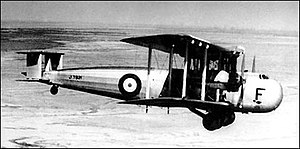avia.wikisort.org - Aeroplane
The Vickers Valentia (company designation Type 264) was a British biplane bomber transport aircraft built by Vickers for the Royal Air Force. The majority built were conversions of the earlier Vickers Victoria, itself derived from the Vickers Virginia.
| Type 264 Valentia | |
|---|---|
 | |
| Role | Bomber Transport |
| Manufacturer | Vickers |
| Introduction | 1934 |
| Retired | 1944 |
| Primary user | Royal Air Force |
| Developed from | Vickers Victoria |
Design and development
While the Napier Lion-powered Victoria served successfully with the RAF as a bomber transport, by 1932, the Lion engine was becoming obsolete and it was clear that it could use more power. It was therefore decided to re-engine the aircraft with more powerful Bristol Pegasus engines.[1] It was decided to carry out a two-stage upgrade, with the first, designated the Victoria Mk VI or Configuration I, having a limited maximum weight. This was followed by Configuration 2 which was capable of taking full advantage of the greater power of the Pegasus engine by virtue of a strengthened airframe featuring a strengthened wing, strut rather than wire-braced landing gear, wheel brakes and a tailwheel in place of a skid. This became the Vickers Valentia Mk I[1] which flew for the first time in 1934.
Orders were placed for the 28 new build Valentias to Specification 30/34, with a further 54 being converted from Victorias (Type 278 within the company), with production continuing until 1936.[1]
In 1938 a version with Pegasus IIM3 engines (which offered improved 'hot and high' performance) was supplied for service with one flight of No. 31 Squadron then based in Lahore.
Operational history
The Valentia first entered service with No. 70 Squadron RAF at Hinaidi, Iraq in 1934,[2] equipping British forces in India, Persia and Iraq.
Like the preceding Vernons and Victorias, the Valentias were extensively used for transport operations in the Middle East, and when necessary used for bombing operations with bomb racks under the wings. Valentias were also experimentally fitted with loudspeakers used to address people being overflown (in this case potentially rebellious tribes during air policing duties).[1] The Valentia was also used for experiments with aerial refuelling by Alan Cobham.[1]
Valentias were used for night bombing operations over the Western Desert in 1940.[1] In service with No. 31 Squadron RAF and the RAF Communications Flight Iraq, they took part in the 1941 Siege of RAF Habbaniya and subsequent operations. They then remained in service with the Communications Flight Iraq (later Iraq & Persia) until 1944.[3][4][5] The South African Air Force pressed a Valentia into service as a bomber in the East African Campaign in 1940–41.[6]
The Valentia was replaced as a transport in RAF service by the Bristol Bombay.[7]
Variants
- Valentia Mk I : Military transport aircraft for the RAF.
Operators
 India
India
- Royal Indian Air Force
 South Africa
South Africa
- South African Air Force
 United Kingdom
United Kingdom
- Royal Air Force
- No. 31 Squadron RAF
- No. 70 Squadron RAF
- No. 216 Squadron RAF
- Communication Flight Iraq
Specifications (Valentia Mk. I)
Data from Aircraft of the Royal Air Force[2]
General characteristics
- Crew: 2
- Capacity: 22 troops
- Length: 59 ft 6 in (18.14 m)
- Wingspan: 87 ft 4 in (26.62 m)
- Height: 17 ft 9 in (5.41 m)
- Wing area: 2,178 sq ft (202.3 m2)
- Empty weight: 10,944 lb (4,964 kg)
- Gross weight: 19,500 lb (8,845 kg)
- Powerplant: 2 × Bristol Pegasus II L3 or M3 radial engines, 650 hp (480 kW) each
Performance
- Maximum speed: 130 mph (210 km/h, 110 kn) at 5,000 ft (1,500 m)
- Cruise speed: 117 mph (188 km/h, 102 kn)
- Range: 800 mi (1,300 km, 700 nmi)
- Service ceiling: 16,250 ft (4,950 m)
- Rate of climb: 700 ft/min (3.6 m/s)
Armament
- Bombs: Could be fitted with underwing racks for 2,200 lb of bombs
See also
Related lists
- List of aircraft of the Royal Air Force
- List of aircraft of World War II
References
| Wikimedia Commons has media related to Vickers Type 264 Valentia. |
- Andrews, E.N.; Morgan, E.B. (1988). Vickers Aircraft Since 1908 (Second ed.). London: Putnam. pp. 163–171, 176. ISBN 0-85177-815-1.
- Thetford, Owen (1957). Aircraft of the Royal Air Force 1918–57 (1st ed.). London: Putnam. pp. 430–431.
- Jefford
- Lake
- The National Archives, Kew. AIR 29/893
- "Roll Out the Barrel". Time Magazine. 4 December 1944. Archived from the original on 30 September 2007. Retrieved 31 August 2007.
- Bristol Type 130 Bombay
Bibliography
- Jefford, C.G. (2001). RAF Squadrons, a Comprehensive Record of the Movement and Equipment of all RAF Squadrons and their Antecedents since 1912. Shrewsbury: Airlife Publishing. ISBN 1-84037-141-2.
- Lake, Alan (1999). Flying Units of the RAF, The ancestry, formation and disbandment of all flying units from 1912. Shrewsbury: Airlife Publishing. ISBN 1-84037-086-6.
На других языках
- [en] Vickers Type 264 Valentia
[fr] Vickers Type 264 Valentia
Le Vickers Type 264 Valentia est un avion de transport britannique de l'entre-deux-guerres.Другой контент может иметь иную лицензию. Перед использованием материалов сайта WikiSort.org внимательно изучите правила лицензирования конкретных элементов наполнения сайта.
WikiSort.org - проект по пересортировке и дополнению контента Википедии